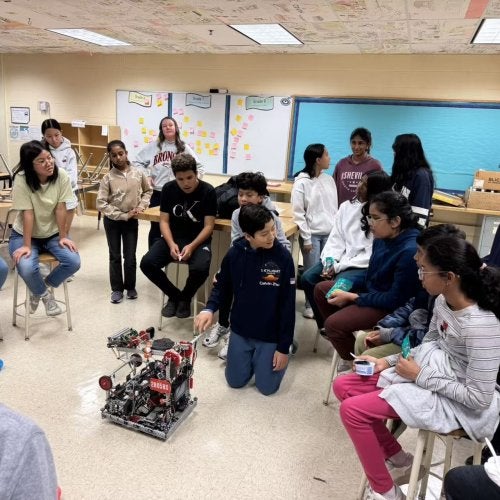The Value of Play for Children’s Learning
Every morning, Mariela’s father brings her to the early education program not far from her home. She gives him a hug, greets her teacher with a big smile, and eagerly skips across the room to the block area where she begins building an intricate structure while chattering happily with her friends. Her father is pleased that Mariela has adjusted so well to her first early educational experience, but he is a little concerned. Will this block play help her as she moves on to kindergarten and the rest of her elementary school years? Mariela’s program is filled with color and excitement, and children busily engaged in many different activities. Her family is appreciative of this opportunity, but how is it helping her get ready for school?
As young children have settled into the routines of school this fall, many families find themselves with the same questions as Mariela’s family. They know about the importance of early childhood education for helping children get ready for kindergarten and beyond, yet the activities in these programs look more like play than traditionally held views of learning in school. No neat rows of desks here: children are clustered together on rugs as the teacher reads, busily experimenting with color at painting easels and rocking baby dolls in the housekeeping corner. No blackboard and chalk: instead, children might gather around a “smart board” or use computer tablets as they explore a topic. No teacher standing at the front of the room—the educators crouch down with the children to examine something through a large magnifier, or pretend to be customers at the “grocery store” constructed from blocks.
Is it possible that this type of exploration and play is an important component of learning? Will the children in early education programs emphasizing developmentally appropriate practices such as those described above gain the skills they need to meet the increasing academic expectations of the early primary years and beyond?
The effects of preschool (also known as pre-k or prekindergarten) on school readiness have been widely researched, particularly with respect to the impact of early education on children who come to school with certain risk factors such as poverty. Research supports the view that high-quality early education programs contribute to children's long-term, healthy development and learning (Gormley, Gayer, & Phillips, 2008). Programs which support children’s strengths and provide positive adult-child interactions will have the greatest influence on their learning (Yoshikawa et al., 2013). The long term effects of early education beyond the first few years on school, as well as the most advantageous types of curricula (Burchinal, 2018) are still open to debate (e.g., Durkin et. al., 2022; Whitehurst, 2018), but there is general consensus that quality preschool programs support children’s transition into kindergarten.
High quality programs use children’s development as a framework for learning. Developmentally Appropriate Practices are “ways of teaching that engage children’s interests and adapt for their age, experience and ability to help them meet challenging and achievable learning goals,” (Bredekamp, 2017, p. 70). This core set of principles, established by the National Association for the Education of Young Children (NAEYC), is the primary framework for considering how best to support children’s learning in early education settings. The basic assumption is that children are optimally supported in settings where they can actively engage in activities of interest to them, which not only take into account the broad developmental factors that influence all young children, but also the specific individual needs and interests that are particular to each and every child. This focus on the individual acknowledges the varying cultural contexts of young children’s lives.
What does this mean for the daily events children experience in early childhood settings? Developmentally appropriate practices (commonly known as DAP) acknowledge the role of play as an essential vehicle for learning. When children participate in engaging activities that are of high personal interest, the opportunities for learning become endless. The intricate block structures that Mariela builds each morning are symbolic representations of stories she has listened to, conduits for exploring physical properties of objects, and experiments in classical physics as she learns through trial and error how to create ramps and pathways, balance objects, or how to build a tall structure that doesn’t collapse. This active participation, endlessly variable through multiple opportunities for variation and experimentation, provides the basis for young children’s engagement in early education. While the actual day-to-day schedule and activities may vary from program to program, good early childhood education understands the value of play for children’s learning.
Below are suggestions from the editorial team at the Center for Early Childhood Education and Intervention for family and teacher resources related to this article by Dr. Klein.
Families can utilize play at home, parks and other places to encourage growth and development in children. Take advantage of these opportunities by promoting learning that is engaging and fun for children.
This article from the National Association for the Education of Young Children (NAEYC) offers a list of ten key benefits of and tips for play for families. Benefits include stress relief, cognitive and emotional development, and improved self-esteem.
10 Things Every Parent Should Know About Play
A piece by Reading Rockets in partnership with NAEYC and the International Reading Association (IRA) highlights helpful DAP teaching practices for children from infancy to primary school-age. Their recommendations highlight how DAP can promote literacy.
Developmentally Appropriate Practices for Young Children: Recommendations for Teaching Practices
Developmentally Appropriate Practices create more opportunities to engage children where they are. By engaging their interests, learning can be made more fun and relevant.
References
Bredekamp, S. (2017) Effective practices in early childhood education. 3rd edition. Boston: Pearson.
Burchinal, M. (2018). Measuring Early Care and Education Quality. Child Development Perspectives, 12 (1), 3–9.
Gormley, W., Gayer, T., & Phillips, D.A. (2008). Preschool programs can boost school readiness. Science, 320, 1723-1724.
Durkin, K., Lipsey, M.W., Farran, D.C., & Wiesen, S.E. (2022). Effects of a statewide pre-kindergarten program on children's achievement and behavior through sixth grade. Dev Psychol, 58 (3), 470-484.
Whitehurst, G. (2018). Commentary: The positive impacts of public Pre-K fade quickly, and sometimes reverse: What does this portend for future research and policy? Early Childhood Research Quarterly, 45 (4), 183-187.
Yoshikawa, H., Weiland, C., Brooks-Gunn, J., Burchinal, M., Espinosa, L.M., Gormley, W.T., Ludwig, J., Magnuson, K., Phillips, D., & Zaslow, M. J. (2013). Investing in our future: The evidence base on preschool education. Society for Research in Child Development and the Foundation for Child Development.
Elisa Klein is Associate Professor in the Department of Human Development and Quantitative Methodology at The University of Maryland, College Park and is a researcher in the Center for Early Childhood Education and Intervention.
The Center for Early Childhood Education and Intervention conducts high quality research on early childhood education and early intervention programs. Visit our website to learn more. You can follow us on X at @CECEIatUMD.



